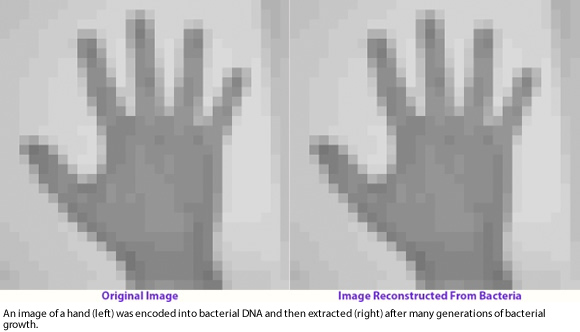
Harvard Scientists Use CRISPR-Cas to Store Movie Clips in DNA
July 19, 2017| |
Scientists from Harvard Medical School in Boston successfully created cellular recording systems that are capable of encoding a series of events in a cell using the CRISPR-Cas system.
Seth Shipman and colleagues designed a system called CRISPR clips, which used the ability to capture DNA fragments from invading viruses and store them in an organized array in the host genome. In nature, the DNA fragments target an enzyme to slice up the invader's DNA. In CRISPR clips, the parts of the DNA corresponded to pixels in an image. They encoded the shading of each pixel, together with a barcode that dictates its location in the image, into 33 DNA letters. Each frame of the clip is composed of 104 of these DNA fragments.
This breakthrough could lead to the use of arrays to monitor gene expression without cracking cells open to remove their RNA.

For more information, read the news release from Nature.
| |
Biotech Updates is a weekly newsletter of ISAAA, a not-for-profit organization. It is distributed for free to over 22,000 subscribers worldwide to inform them about the key developments in biosciences, especially in biotechnology. Your support will help us in our mission to feed the world with knowledge. You can help by donating as little as $10.
-
See more articles:
-
News from Around the World
- Scientists Discuss Upcoming Biosafety Law in Egypt
- Ugandan Government Supports Passage of Biosafety Bill
- Scientists Identify Link Between Plant Nitrogen Uptake and Greenhouse Gas Reductions
- Induced Defences in Tomato Plants Cause Cannibalism among Pests
- USDA Urged to Start Over on Proposed Rule to Revamp Biotech Regulation
- International Team Uncovers How Wheat Lost Battle Against Blast
- CSIRO Releases Australia's Food and Agribusiness Roadmap
- Australian OGTR Approves Field Trial of GM Wheat and Barley
- Scientists Discover Plants Use Calcium to Send Internal Warning Signals of Aphid Attacks
-
Research Highlights
- Pathogen-inducible Ta-Lr34res Expression Confers Disease Resistance in Barley
- Ectopic Expression of OsExtensin-like Gene in Rice Enhances Plant Lodging Resistance
-
Beyond Crop Biotech
- Harvard Scientists Use CRISPR-Cas to Store Movie Clips in DNA
-
Resources
- Beyond Promises: Facts About Biotech/GM Crops in 2016
- ASTA Launches Plant Breeding Animation Video
-
Plant
- Development of Low-Cesium Rice Plants via CRISPR-Cas
-
Read the latest: - Biotech Updates (January 14, 2026)
- Gene Editing Supplement (December 17, 2025)
- Gene Drive Supplement (February 22, 2023)
-
Subscribe to BU: - Share
- Tweet
